
|
|
|
|
 |
|
Home Site Search Contact Us Subscribe
|
|
|
|
Home-grown: Behnisch, Behnisch & Partner Takes on the World
Berlin: "Export" at the German Center for Architecture shows off home-grown talent exporting their architectural finesse around the world. by ArchNewsNow March 15, 2005 If
you’re in Berlin between now and May 1, it will be worth a visit to DAZ/Deutsche Architektur Zentrum (German Center for
Architecture) to see “Export,” an exhibition of 50 projects by
15 German architectural firms whose works have been “exported” to Europe, Asia,
North America, and Africa. Among of the firms in
the show whose international profile – and portfolio – has seen rapid growth in
the last few years (primarily by taking first prize in a number of high-profile
competitions) is Behnisch, Behnisch & Partner. The Stuttgart- and Los
Angeles-based firm is represented by seven projects that particularly
demonstrate the architects’ attention to environmental issues and green
building – as well as cutting-edge design. Senscity
Paradise Universe Las
Vegas, Nevada The Senscity Paradise Universe combines elements of a
typical theme park including a toy gallery, a theater, auditoria, and
restaurants, with landscape and garden features, exhibition spaces, and a
series of playgrounds. The architects have
designed an energy-efficient and enjoyable environment, rising like a green
oasis form the Nevada desert. The “architectural landscape” is a central feature of the design, formed
and modulated using “natural” barriers to separate and protect the park from
its surroundings. A variety of spatial links – green areas, plazas, an
artificial lake, and meandering paths – will make the complex easy to navigate. The park’s
signature will be iconic “desert flowers” – light-weight metal structures
(similar to those used in the airplane industry) up to 120 feet high and 300
feet wide – that will protect the landscape (and visitors) from the desert sun.
Evaporating water on the structures’ expansive “leaves” will
cool the air; their enormous height will generate a down-draft airflow bringing
cool air streams into the public spaces, creating a very comfortable
environment. In addition, the “leaf” surfaces will be cooled down by cold air
on the inside, adding radiant cooling. The leaves can also
be used as energy collectors. Photovoltaic cells or solar collectors can
transform radiation into electricity or heat. A vertical axis wind turbine in
the center of a flower could transform wind into electricity. Transsolar Energietechnik of Stuttgart,
Germany is the Energy Concept Consultant. The project is
currently in design development and could break ground as early as next year. Moscow City
Transport Terminal (MCTT)
Moscow,
Russia Scheduled to open in 2009, the Moscow City Transport
Terminal will be a gateway at the heart of the ever-growing “Moscow City” development. The 2.1
million-square-foot complex will include retail, restaurants, and an
entertainment center. High above the Terminal’s public concourse, a public winter garden will
provide access to office space, service apartments, a hotel, and a wellness
center. The Transport
Terminal will operate independently of other areas. There will be direct
underground connections to neighboring properties and the Moscow Metro System, as well as underground
parking for 1,000 cars. The design responds to the desire to temper the
extremes of climate, optimize the use of daylight, take advantage of the views
across Moscow, and combine a variety of operations within a new landmark
building. Millenium Biologix Headquarters and
Master Plan Kingston, Ontario, Canada Behnisch,
Behnsich & Partner’s master plan for the international headquarters of the
biotechnology company Millenium Biologix includes sustainable design guidelines
for future development of the 18.3-acre site. The triangular site slopes 20 feet
from its northern boundary (bordered by a regional airport) down to its
southern edge on Horsey Bay on Lake Ontario. The natural environment is
incorporated into the design of the 53,820-square-foot headquarters building
itself. The site’s terrain – a limestone stratum – inspired the building’s
layered appearance and limestone façade. A slender, two-story center hub, or
“villa,” will house administrative offices, a cafeteria, meeting rooms,
exhibition space, and storage and delivery rooms. Various one-level wings
housing production facilities will have planted rooftops and extend from the
center villa as if they were a continuation of the landscape. Carved into the
sloped site, the generously-sized terraces are open spaces for informal
meetings and relaxation. The building is fully oriented to the south, with
expansive views of the lake and an abundance of natural light in interior
spaces. The architects’ zero-impact approach
includes a number of sustainable solutions to reduce dependency on mechanical
systems, increase reliance on natural energy sources for climatic control,
maintain unspoiled lake views, and protect animal and plant life indigenous to
the site. The limited depth of the building forms will use daylight and
prevailing winds for natural ventilation and cooling. Thick limestone walls
help retain and dissipate heat while the lake’s stable water temperature
assists the winds in cooling the structure further. The
building is scheduled for completion in 2006. Shoalts and Zaback Architects,
Kingston, Ontario, is the Executive Architect for the project. Other team
members include: Knippers Helbig, Stuttgart, Germany (Civil Engineer); HH Angus
& Associates, Toronto (Mechanical, Electrical, Plumbing Engineer); and Transsolar
Energietechnik, Stuttgart, Germany (Environmental Consultant). “Ozeaneum”
German Oceanographic Museum Stralsund, Germany Stralsund is a
weather-beaten, urban city on the Baltic Sea with a long history of trade. The Oceanographic
Museum will be a new iconic landmark in the heart of the city – a harbor promenade surrounded by historic warehouses –
oriented toward the sea. The 158,000-square-foot museum has no “front” or “back.” Instead, four light-filled
volumes, with a variety of glazed façades and roofs offering interesting views from all
sides into and through the complex, will house different functions. The
seaside volume, which includes a gift shop and cafe, will lead to two aquariums
– the North Sea and the Baltic Sea, as well as a “Sea for Children” and a
penguin garden on the rooftop. The fourth volume will house a huge whale
replica. All will be connected via stairways, elevators, and footbridges. Visitors coming from the
city center will reach the museum via two
bridges. Round, green “seat cushions,” made of steel rings planted with grass
that moves in the wind and illuminated at night, will seem to “float” above the
ground, and inviting visitors to rest. Solid floor slabs extend from the
outside to the interior. A water cooling system passing through the structural
elements and the pile foundations will reduce the heat loads produced by both
visitors and the technical installations. (A basement level was omitted to save
costs.) The building’s curtainwall of large wooden panels are intended to age
in the rough climate, like a sculpture shaped by wind and weather. Construction
is expected to be completed in 2008. Back to “Export” Other Behnisch,
Behnisch & Partner projects in “Export”: the Institute for Forestry and Nature
Research in Wageningen, Netherlands. This is the firm’s first building outside
of Germany (a 1993 competition-winning design completed in 1998), and an early
EU pilot project touted as a humane and environmentally friendly building. Also
included is the highly-acclaimed Genzyme Center in Cambridge, Massachusetts,
which opened in 2004 and is set to receive a platinum LEED rating, the highest
environmental rating by the U.S. Green Building Council. Plans, renderings, and
concept studies for an administration building for the World Intellectual
Property Organization in Geneva, Switzerland (2006), and an urban housing development at
Valdamara Park in Riga, Latvia, are also on view. Behnisch, Behnisch & Partner, founded in 1989 as a spin-off of Behnisch & Partner, is under the
leadership of Stefan Behnisch and
Günther Schaller in Stuttgart, Germany, and principal Christof Jantzen,
AIA, in Venice, California.
Other
firms participating in “Export” include: Auer+Weber+Architekten;
Barkow Leibinger Architekten; Behnisch, Behnisch + Partner Architekten;
BOLLES+WILSON; Eller + Eller Architekten; heide von beckerath alberts
architekten; Henn Architekten; Ingenhoven und Partner Architekten; J. Mayer H.
Architekten; Jan Kleihues und Klaus Schuwerk; Knebel & von Wedemeyer
Architekten; KSP Engel Zimmermann Architekten; Léon Wohlhage Wernik Architekten
mit Werner Sobek Ing. und Transsolar; modulorbeat; and Rang + Volz Architekten. |
(click on pictures to enlarge) 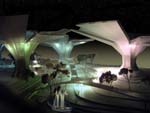 (Behnisch, Behnisch & Partner) Senscity Paradise Universe, Las Vegas, by night (Behnisch, Behnisch & Partner) Senscity main concourse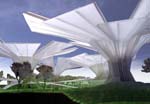 (Behnisch, Behnisch & Partner) Senscity auditorium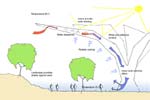 (Behnisch, Behnisch & Partner) Senscity evaporation/cooling diagram (Behnisch, Behnisch & Partner) Senscity master plan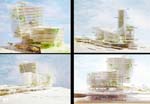 (Behnisch, Behnisch & Partner) Moscow City Transport Terminal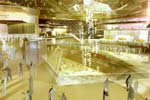 (Behnisch, Behnisch & Partner) Transport Terminal public concourse (Behnisch, Behnisch & Partner) Transport Terminal public concourse (Behnisch, Behnisch & Partner) Millenium Biologix west elevation (Behnisch, Behnisch & Partner) Millenium Biologix east elevation (Behnisch, Behnisch & Partner) Millenium Biologix roof, interior of upper level, interior of lower level (Behnisch, Behnisch & Partner) Millenium Biologix roof, interior of upper level, interior of lower level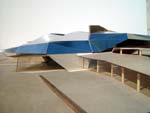 (Behnisch, Behnisch & Partner) Model: Millenium Biologix headquarters building (Behnisch, Behnisch & Partner) Oceanographic Museum harbor-side view (Behnisch, Behnisch & Partner) Oceanographic Museum harbor-side view (Behnisch, Behnisch & Partner) Oceanographic Museum city-side view (Behnisch, Behnisch & Partner) Oceanographic Museum section north (Behnisch, Behnisch & Partner) Oceanographic Museum section showing exhibition of eastern seas (Behnisch, Behnisch & Partner) Oceanographic Museum section showing exhibition of giant whale |
© 2005 ArchNewsNow.com